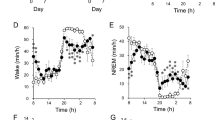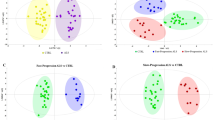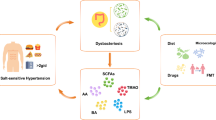Abstract
Salt-sensitive hypertension (SSH) is a major risk factor for cardiovascular disease, but its metabolic mechanisms remain unclear. This study investigates the plasma metabolic profile of SSH patients to identify potential therapeutic targets. Additionally, SSH patients were identified through an oral salt-loading test. Plasma metabolomics was performed by utilizing GC-MS and LC-MS, followed by network correlation analysis, pathway enrichment, receiver operating characteristic analysis, and linear regression analysis. The findings were validated in Dahl salt-sensitive (SS) rats, with glycine supplementation evaluated as a potential therapeutic intervention. Firstly, plasma metabolomics illustrated distinct metabolic alterations in SSH patients, with substantially increased levels of fumaric acid, pyruvat,e and lactic acid, as well as significantly decreased levels of glycine, leucine and β-alanine (p < 0.05). Additionally, Glycine and β-alanine levels decreased by 61% and 68% compared to the control group. Secondly, pathway enrichment analysis identified disruptions in amino acid metabolism, particularly Arginine biosynthesis pathway, TCA pathway, glycine, serine, and threonine metabolism pathways were significantly enriched (p < 0.05). Correlation network analysis identified fumarate as a hub metabolite in the pathophysiology of SSH. Glycine showed the highest predictive value for SSH (AUC = 94.6181%) and was negatively correlated with blood pressure. Finally, glycine supplementation in SS rats substantially reduced salt-induced hypertension (p < 0.001) by improving renal amino acid metabolism and enhancing nitric oxide production. This study identifies glycine as a crucial metabolic target for SSH intervention. Glycine supplementation effectively alleviates SSH in animal models, indicating its potential for clinical applications. Future research should focus on exploring glycine-based therapies in clinical trials.

Intervention targets and validation of salt-sensitive hypertension
This is a preview of subscription content, access via your institution
Access options
Subscribe to this journal
Receive 12 print issues and online access
$259.00 per year
only $21.58 per issue
Buy this article
- Purchase on SpringerLink
- Instant access to full article PDF
Prices may be subject to local taxes which are calculated during checkout






Similar content being viewed by others
References
Mensah G, Fuster V, Murray C, Roth G. Global burden of cardiovascular diseases and risks, 1990-2022. J Am Coll Cardiol. 2023;82:2350–473.
NCD Risk Factor Collaboration (NCD-RisC). Worldwide trends in hypertension prevalence and progress in treatment and control from 1990 to 2019: a pooled analysis of 1201 population-representative studies with 104 million participants. Lancet. 2021;398:957–80.
Denton D, Weisinger R, Mundy N, Wickings E, Dixson A, Moisson P, et al. The effect of increased salt intake on blood pressure of chimpanzees. Nat Med. 1995;1:1009–16.
Suckling R, He F, Markandu N, MacGregor G. Dietary salt influences postprandial plasma sodium concentration and systolic blood pressure. Kidney Int. 2012;81:407–11.
Shi M, He J, Li C, Lu X, He W, Cao J, et al. Metabolomics study of blood pressure salt-sensitivity and hypertension. Nutr Metab Cardiovasc Dis. 2022;32:1681–92.
Elijovich F, Weinberger M, Anderson C, Appel L, Bursztyn M, Cook N, et al. Salt sensitivity of blood pressure: a scientific statement from the American Heart Association. Hypertension. 2016;68:e7–46.
Rust P, Ekmekcioglu C. Impact of salt intake on the pathogenesis and treatment of hypertension. Adv Exp Med Biol. 2017;956:61–84.
Mu J, Zheng S, Lian Q, Liu F, Liu Z. Evolution of blood pressure from adolescents to youth in salt sensitivies: a 18-year follow-up study in Hanzhong children cohort. Nutr J. 2012;11:70.
Wang L, Hou E, Wang L, Wang Y, Yang L, Zheng X, et al. Reconstruction and analysis of correlation networks based on GC-MS metabolomics data for young hypertensive men. Anal Chim Acta. 2015;854:95–105.
Tian Z, Liang M. Renal metabolism and hypertension. Nat Commun. 2021;12:963.
Cheng Y, Song H, Pan X, Xue H, Wan Y, Wang T, et al. Urinary metabolites associated with blood pressure on a low- or high-sodium diet. Theranostics. 2018;8:1468–80.
Zheng X, Zhou L, Jin Y, Zhao X, Ahmad H, OuYang Y, et al. Beta-aminoisobutyric acid supplementation attenuated salt-sensitive hypertension in Dahl salt-sensitive rats through prevention of insufficient fumarase. Amino Acids. 2022;54:169–80.
Zheng X, Li X, Chen M, Yang P, Zhao X, Zeng L, et al. The protective role of hawthorn fruit extract against high salt-induced hypertension in Dahl salt-sensitive rats: impact on oxidative stress and metabolic patterns. Food Funct. 2019;10:849–58.
Ou Yang Y, Yuan M, Yang Z, Min Z, Jin Y, Tian Z. Revealing the pathogenesis of salt-sensitive hypertension in Dahl salt-sensitive rats through integrated multi-omics analysis. Metabolites. 2022;12:1076.
Qu X, Gao H, Sun J, Tao L, Zhang Y, Zhai J, et al. Identification of key metabolites during cisplatin-induced acute kidney injury using an HPLC-TOF/MS-based non-targeted urine and kidney metabolomics approach in rats. Toxicology. 2020;431:152366.
Yang P, Deng F, Yuan M, Chen M, Zeng L, Ouyang Y, et al. Metabolomics reveals the defense mechanism of histidine supplementation on high-salt exposure-induced hepatic oxidative stress. Life Sci. 2023;314:121355.
Zhao H, Liu Y, Li Z, Song Y, Cai X, Liu Y, et al. Identification of essential hypertension biomarkers in human urine by non-targeted metabolomics based on UPLC-Q-TOF/MS. Clin Chim Acta. 2018;486:192–8.
Lin W, Liu Z, Zheng X, Chen M, Gao D, Tian Z. High-salt diet affects amino acid metabolism in plasma and muscle of Dahl salt-sensitive rats. Amino Acids. 2018;50:1407–14.
Li H, Liu Q, Zou Z, Chen Q, Wang W, Baccarelli A, et al. L-arginine supplementation to mitigate cardiovascular effects of walking outside in the context of traffic-related air pollution in participants with elevated blood pressure: A randomized, double-blind, placebo-controlled trial. Environ Int. 2021;156:106631.
Zeng L, Chen M, Ahmad H, Zheng X, Ouyang Y, Yang P, et al. Momordica charantia extract confers protection against hypertension in Dahl salt-sensitive rats. Plant Foods Hum Nutr. 2022;77:373–82.
Rapp J, Garrett M. Will the real Dahl S rat please stand up? Am J Physiol Renal Physiol. 2019;317:F1231–40.
Rettig R. Does the kidney play a role in the aetiology of primary hypertension? Evidence from renal transplantation studies in rats and humans. J Hum Hypertens. 1993;7:177–80.
Zheng X, Chen M, Li X, Yang P, Zhao X, Ouyang Y, et al. Insufficient fumarase contributes to hypertension by an imbalance of redox metabolism in Dahl salt-sensitive rats. Hypertens Res. 2019;42:1672–82.
Liang M. Hypertension as a mitochondrial and metabolic disease. Kidney Int. 2011;80:15–6.
Rinschen M, Palygin O, Guijas C, Palermo A, Palacio-Escat N, Domingo-Almenara X, et al. Metabolic rewiring of the hypertensive kidney. Sci Signal. 2019;12:eaax9760.
Rinschen M, Palygin O, El-Meanawy A, Domingo-Almenara X, Palermo A, Dissanayake L, et al. Accelerated lysine metabolism conveys kidney protection in salt-sensitive hypertension. Nat Commun. 2022;13:4099.
Dissanayake L, Palygin O, Staruschenko A. Lysine and salt-sensitive hypertension. Curr Opin Nephrol Hypertens. 2024;33:441–6.
Stamler J, Brown I, Daviglus M, Chan Q, Kesteloot H, Ueshima H, et al. Glutamic acid, the main dietary amino acid, and blood pressure: the INTERMAP Study (International Collaborative Study of Macronutrients, Micronutrients and Blood Pressure). Circulation. 2009;120:221–8.
Semnani-Azad Z, Toledo E, Babio N, Ruiz-Canela M, Wittenbecher C, Razquin C, et al. Plasma metabolite predictors of metabolic syndrome incidence and reversion. Metabolism. 2024;151:155742.
Wang Z, Cheng C, Yang X, Zhang C. L-phenylalanine attenuates high salt-induced hypertension in Dahl SS rats through activation of GCH1-BH4. PLoS One. 2021;16:e0250126.
Tian Z, Greene A, Usa K, Matus I, Bauwens J, Pietrusz J, et al. Renal regional proteomes in young Dahl salt-sensitive rats. Hypertension. 2008;51:899–904.
Tian Z, Liu Y, Usa K, Mladinov D, Fang Y, Ding X, et al. Novel role of fumarate metabolism in Dahl-salt sensitive hypertension. Hypertension. 2009;54:255–60.
Usa K, Liu Y, Geurts A, Cheng Y, Lazar J, Baker M, et al. Elevation of fumarase attenuates hypertension and can result from a nonsynonymous sequence variation or increased expression depending on rat strain. Physiol Genomics. 2017;49:496–504.
Hou E, Sun N, Zhang F, Zhao C, Usa K, Liang M, et al. Malate and aspartate increase L-arginine and nitric oxide and attenuate hypertension. Cell Rep. 2017;19:1631–9.
Dziedzic M, Józefczuk E, Guzik T, Siedlinski M. Interplay between plasma glycine and branched-chain amino acids contributes to the development of hypertension and coronary heart disease. Hypertension. 2024;81:1320–31.
Lin C, Sun Z, Mei Z, Zeng H, Zhao M, Hu J, et al. The causal associations of circulating amino acids with blood pressure: a Mendelian randomization study. BMC Med. 2022;20:414.
Li X, Sun L, Zhang W, Li H, Wang S, Mu H, et al. Association of serum glycine levels with metabolic syndrome in an elderly Chinese population. Nutr Metab. 2018;15:89.
Ertuglu L, Mutchler A, Yu J, Kirabo A. Inflammation and oxidative stress in salt sensitive hypertension; the role of the NLRP3 inflammasome. Front Physiol. 2022;13:1096296.
Wang Z, Zhang J, Wang L, Li W, Chen L, Li J, et al. Glycine mitigates renal oxidative stress by suppressing Nox4 expression in rats with streptozotocin-induced diabetes. J Pharmacol Sci. 2018;137:387–94.
Diaz-Flores M, Cruz M, Duran-Reyes G, Munguia-Miranda C, Loza-Rodriguez H, Pulido-Casas E, et al. Oral supplementation with glycine reduces oxidative stress in patients with metabolic syndrome, improving their systolic blood pressure. Can J Physiol Pharmacol. 2013;91:855–60.
Ruiz-Ramírez A, Ortiz-Balderas E, Cardozo-Saldaña G, Diaz-Diaz E, El-Hafidi M. Glycine restores glutathione and protects against oxidative stress in vascular tissue from sucrose-fed rats. Clin Sci (Lond). 2014;126:19–29.
Perez-Torres I, Ibarra B, Soria-Castro E, Torrico-Lavayen R, Pavon N, Diaz-Diaz E, et al. Effect of glycine on the cyclooxygenase pathway of the kidney arachidonic acid metabolism in a rat model of metabolic syndrome. Can J Physiol Pharmacol. 2011;89:899–910.
Liang M, Knox F. Production and functional roles of nitric oxide in the proximal tubule. Am J Physiol Regul Integr Comp Physiol. 2000;278:R1117–24.
Elijovich F, Laffer C, Sahinoz M, Pitzer A, Ferguson J, Kirabo A. The gut microbiome, inflammation, and salt-sensitive hypertension. Curr Hypertens Rep. 2020;22:79.
Mattson D, Lund H, Guo C, Rudemiller N, Geurts A, Jacob H. Genetic mutation of recombination activating gene 1 in Dahl salt-sensitive rats attenuates hypertension and renal damage. Am J Physiol Regul Integr Comp Physiol. 2013;304:R407–14.
McMaster W, Kirabo A, Madhur M, Harrison D. Inflammation, immunity, and hypertensive end-organ damage. Circ Res. 2015;116:1022–33.
Zhang W, Zheng X, Du L, Sun J, Shen Z, Shi C, et al. High salt primes a specific activation state of macrophages, M(Na). Cell Res. 2015;25:893–910.
Madhur M, Lob H, McCann L, Iwakura Y, Blinder Y, Guzik T, et al. Interleukin 17 promotes angiotensin II-induced hypertension and vascular dysfunction. Hypertension. 2010;55:500–7.
Spittler A, Reissner C, Oehler R, Gornikiewicz A, Gruenberger T, Manhart N, et al. Immunomodulatory effects of glycine on LPS-treated monocytes: reduced TNF-alpha production and accelerated IL-10 expression. FASEB J. 1999;13:563–71.
Stachlewitz R, Li X, Smith S, Bunzendahl H, Graves L, Thurman R. Glycine inhibits growth of T lymphocytes by an IL-2-independent mechanism. J Immunol. 2000;164:176–82.
Aguayo-Cerón K, Sánchez-Muñoz F, Gutierrez-Rojas R, Acevedo-Villavicencio L, Flores-Zarate A, Huang F, et al. Glycine: the smallest anti-inflammatory micronutrient. Int J Mol Sci. 2023;24:11236.
Zhang Y, Jia H, Jin Y, Liu N, Chen J, Yang Y, et al. Glycine attenuates LPS-induced apoptosis and inflammatory cell infiltration in mouse liver. J Nutr. 2020;150:1116–25.
Liu R, Liao X, Pan M, Tang J, Chen S, Zhang Y, et al. Glycine exhibits neuroprotective effects in ischemic stroke in rats through the inhibition of M1 microglial polarization via the NF-κB p65/HIF-1α signaling pathway. J Immunol. 2019;202:1704–14.
Hasegawa S, Ichiyama T, Sonaka I, Ohsaki A, Okada S, Wakiguchi H, et al. Cysteine, histidine and glycine exhibit anti-inflammatory effects in human coronary arterial endothelial cells. Clin Exp Immunol. 2012;167:269–74.
Almanza-Perez J, Alarcon-Aguilar F, Blancas-Flores G, Campos-Sepulveda A, Roman-Ramos R, Garcia-Macedo R, et al. Glycine regulates inflammatory markers modifying the energetic balance through PPAR and UCP-2. Biomed Pharmacother. 2010;64:534–40.
Nguyen P, Zhao D, Okamura T, Chang K, Wong N, Yang E. Atherosclerotic cardiovascular disease risk prediction models in China, Japan, and Korea: implications for east Asians? JACC Asia. 2025;5:333–49.
Kario K, Wang J. Toward “Zero” cardiovascular events in Asia: the HOPE Asia network. JACC Asia. 2021;1:121–4.
Acknowledgements
We are very grateful to Qingjian County People’s Hospital in Yulin, Shaanxi Province for their support and assistance during the plasma sample collection process. We were very grateful to the animal wardens (Ying Guo) for taking care of the rats before this experiment. We are grateful to Xiao-Fei Wang and Lin Han (Biomedical Experimental Center of Xi’an Jiaotong University) for their technical support. We thank Shanghai Tengyun Biotechnology Co., Ltd. for developing Hiplot Pro platform and providing technical assistance.
Funding
This work was supported by the National Natural Science Foundation of China (Grant numbers 82370726 and 82400684), Shaanxi Province Postdoctoral Science Foundation [grant number 2024BSHYDZZ003], Youth Project of the Basic Research Program of Shaanxi Provincial Natural Science Foundation (Grant number 2025JC-YBQN-1193) and the Fundamental Research Funds for the Central Universities (Grant number sxzy012025067).
Author information
Authors and Affiliations
Corresponding author
Ethics declarations
Conflict of interest
The authors declare no competing interests.
Additional information
Publisher’s note Springer Nature remains neutral with regard to jurisdictional claims in published maps and institutional affiliations.
Supplementary information
Rights and permissions
Springer Nature or its licensor (e.g. a society or other partner) holds exclusive rights to this article under a publishing agreement with the author(s) or other rightsholder(s); author self-archiving of the accepted manuscript version of this article is solely governed by the terms of such publishing agreement and applicable law.
About this article
Cite this article
Yang, P., Chen, X., Liu, M. et al. Human plasma metabolomics reveals metabolic targets for intervention in salt-sensitive hypertension. Hypertens Res 48, 2567–2583 (2025). https://doi.org/10.1038/s41440-025-02280-2
Received:
Revised:
Accepted:
Published:
Issue date:
DOI: https://doi.org/10.1038/s41440-025-02280-2



